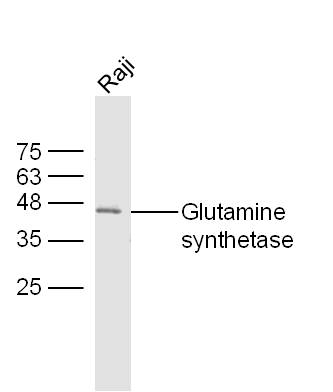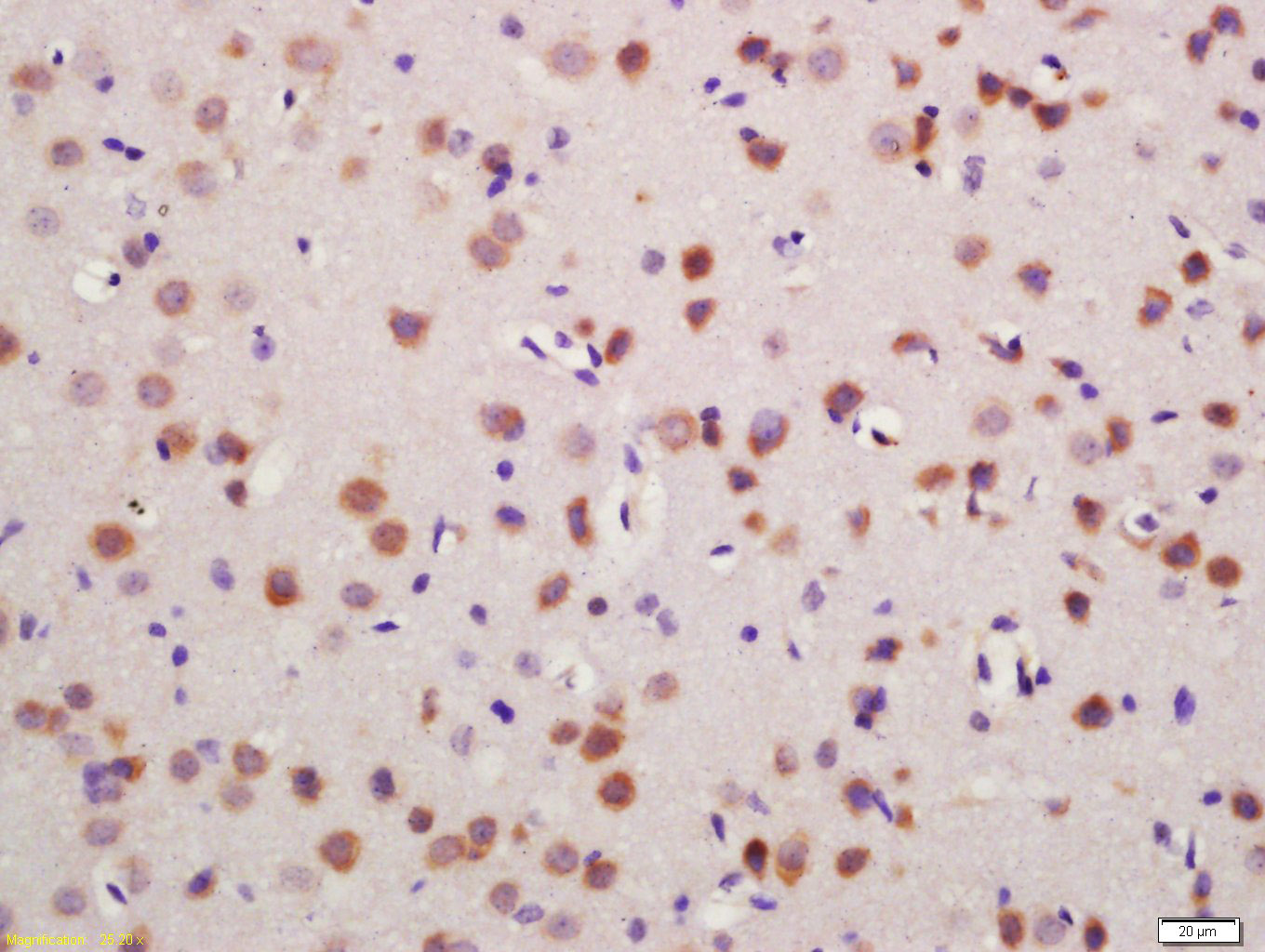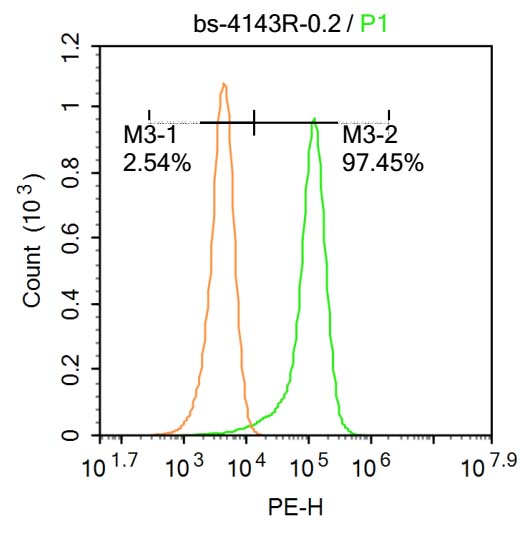
Rabbit Anti-Glutamine synthetase antibody
GLUL; cell proliferation-inducing protein 59; GLNA; GLNA_HUMAN; GLNS; Glutamate ammonia ligase; Glutamate decarboxylase; Glutamate--ammonia ligase; glutamine synthase; GS; PIG 43; PIG 59; PIG43; PIG59; Proliferation inducing protein 43.
View History [Clear]
Details
Product Name Glutamine synthetase Chinese Name 谷氨酰胺合成酶/谷氨酸氨连接酶抗体 Alias GLUL; cell proliferation-inducing protein 59; GLNA; GLNA_HUMAN; GLNS; Glutamate ammonia ligase; Glutamate decarboxylase; Glutamate--ammonia ligase; glutamine synthase; GS; PIG 43; PIG 59; PIG43; PIG59; Proliferation inducing protein 43. literatures Research Area immunology Neurobiology Signal transduction Mitochondrion Alzheimer's Immunogen Species Rabbit Clonality Polyclonal React Species Human, (predicted: Mouse, Rat, Dog, Pig, Cow, Horse, Rabbit, ) Applications WB=1:500-2000 ELISA=1:5000-10000 IHC-P=1:100-500 IHC-F=1:100-500 IF=1:100-500 (Paraffin sections need antigen repair)
not yet tested in other applications.
optimal dilutions/concentrations should be determined by the end user.Theoretical molecular weight 42kDa Cellular localization cytoplasmic Mitochondrion Form Liquid Concentration 1mg/ml immunogen KLH conjugated synthetic peptide derived from human Glutamine synthetase: 285-373/373 Lsotype IgG Purification affinity purified by Protein A Buffer Solution 0.01M TBS(pH7.4) with 1% BSA, 0.03% Proclin300 and 50% Glycerol. Storage Shipped at 4℃. Store at -20 °C for one year. Avoid repeated freeze/thaw cycles. Attention This product as supplied is intended for research use only, not for use in human, therapeutic or diagnostic applications. PubMed PubMed Product Detail Glutamine Synthetase catalyzes the conversion of ammonia and glutamate to glutamine. It is found in astrocytes as an octamer of identical 42 kDa subunits. The function of Glutamine Synthetase is the detoxification of brain ammonia. It also has an important role in the metabolic regulation of neurotransmitter glutamate. Because of the multiple functions and importance of Glutamine Synthetase in cellular metabolism, both catalytic activities and synthesis are highly regulated. The activity of Glutamine Synthetase is controlled by adenylylation. Its activity is decreased in the cerebral cortex of brains affected by Alzheimer's disease, particularly in the vicinity of senile plaques. It is also decreased under conditions of glucose deprivation. The level of expression of Glutamine Synthetase is increased during ischemia in vivo or hypoxia in culture.
Function:
This enzyme has 2 functions: it catalyzes the production of glutamine and 4-aminobutanoate (gamma-aminobutyric acid, GABA), the latter in a pyridoxal phosphate-independent manner (By similarity). Essential for proliferation of fetal skin fibroblasts.
Subcellular Location:
Cytoplasm. Mitochondrion.
DISEASE:
Defects in GLUL are the cause of congenital systemic glutamine deficiency (CSGD) [MIM:610015]. CSGD is a rare developmental disorder with severe brain malformation resulting in multi-organ failure and neonatal death. Glutamine is largely absent from affected patients serum, urine and cerebrospinal fluid.
Similarity:
Belongs to the glutamine synthetase family.
SWISS:
P15104
Gene ID:
2752
Database links:Entrez Gene: 2752 Human
Entrez Gene: 14645 Mouse
Omim: 138290 Human
SwissProt: P15104 Human
SwissProt: P15105 Mouse
Unigene: 518525 Human
Unigene: 210745 Mouse
Unigene: 2204 Rat
Product Picture
Primary: Anti- Glutamine synthetase (SL4143R) at 1/300 dilution
Secondary: IRDye800CW Goat Anti-Rabbit IgG at 1/20000 dilution
Predicted band size: 42 kD
Observed band size: 42 kD
Tissue/cell: mouse brain tissue; 4% Paraformaldehyde-fixed and paraffin-embedded;
Antigen retrieval: citrate buffer ( 0.01M, pH 6.0 ), Boiling bathing for 15min; Block endogenous peroxidase by 3% Hydrogen peroxide for 30min; Blocking buffer (normal goat serum,C-0005) at 37℃ for 20 min;
Incubation: Anti-Glutamine synthetase Polyclonal Antibody, Unconjugated(SL4143R) 1:200, overnight at 4°C, followed by conjugation to the secondary antibody(SP-0023) and DAB(C-0010) staining
Blank control:Molt-4.
Primary Antibody (green line): Rabbit Anti-Glutamine synthetase antibody (SL4143)
Dilution: 1μg /10^6 cells;
Isotype Control Antibody (orange line): Rabbit IgG .
Secondary Antibody : Goat anti-rabbit IgG-PE
Dilution: 1μg /test.
Protocol
The cells were fixed with 4% PFA (10min at room temperature)and then permeabilized with 0.1% PBST for 20 min at room temperature. The cells were then incubated in 5%BSA to block non-specific protein-protein interactions for 30 min at at room temperature .Cells stained with Primary Antibody for 30 min at room temperature. The secondary antibody used for 40 min at room temperature. Acquisition of 20,000 events was performed.
References (0)
No References
Bought notes(bought amounts latest0)
No one bought this product
User Comment(Total0User Comment Num)
- No comment





 +86 571 56623320
+86 571 56623320
 +86 18668110335
+86 18668110335

